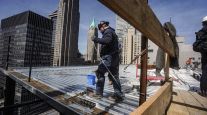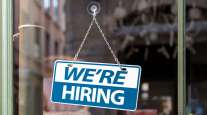Jobless Claims Holding Just Above Four-Decade Low

Applications for unemployment benefits in the United States are hovering close to a four-decade low, a sign of muted firings and steady progress in the labor market.
Jobless claims rose by 5,000 to 274,000 in the week ended Aug. 8, from a revised 269,000 in the prior period, a report from the Labor Department showed. The four-week moving average, a less-volatile measure of job cuts, declined to the lowest level in more than 15 years.
Limited staffing reductions indicate employers are content with headcounts as U.S. demand holds up against weaker global markets. Another report Aug. 13 showed retail sales climbed in July as hiring keeps consumers spending and the economy growing.
“We haven’t seen claims at a 300,000 level since February, and the economy has shown a lot of signs of improvement since then, ignoring what’s going on beyond the borders,” Jennifer Lee, a senior economist at BMO Capital Markets in Toronto, said before the report.
Figures from the Commerce Department released at the same time showed sales at the nation’s retailers climbed 0.6% last month, led by purchases of cars and furniture. Eleven of the 13 major retail categories increased.
The median forecast in a Bloomberg News survey called for no change in jobless claims from the 270,000 previously reported in the prior week. Estimates of the 50 economists ranged from 260,000 to 281,000. Applications for benefits dropped to 255,000 in mid-July, the lowest level since November 1973.
The four-week moving average, a less volatile measure than the weekly numbers, decreased to 266,250 last week, the lowest since the week ended April 15, 2000, from 268,000.
No states estimated data last week, and nothing unusual was in the report, the Labor Department said.
The number of people continuing to receive jobless benefits rose by 15,000 to 2.27 million in the week ended Aug. 1. The unemployment rate among people eligible for benefits held at 1.7%. These data are reported with a one-week lag.
Beginning in March, claims have remained below the 300,000 level that economists say is typically consistent with an improving job market.
Limited dismissals have been accompanied by steady hiring. U.S. companies added 211,000 workers on average this year through July compared with 281,000 a month in the last half of 2014.
Such job growth has moved Federal Reserve policymakers closer to their first increase in interest rates since 2006. The policymaking Federal Open Market Committee next meets Sept. 16-17.
New York Fed President William Dudley said Aug. 12 that the central bank is approaching the moment when it can start raising interest rates, though the timing will be dictated by incoming economic data.
Another report Aug. 13 from the Labor Department showed limited signs of inflation. Prices of imported merchandise and materials dropped 0.9% in July, the biggest decline since January. Excluding fuels, the cost of goods made overseas decreased 2.6% from July 2014, the most since October 2009.
While he’s not sure when lift-off will begin, Dudley said during a speech in Rochester, New York, that “clearly we’ve made a lot of progress over the last couple of years, so we’re certainly getting nearer to that point in time.”
Odds of a September rate move have declined from 54% on Aug. 7 amid global financial market volatility spurred by the surprise decision of the People’s Bank of China on Aug. 11 to devalue the yuan.



